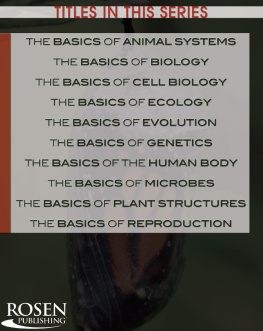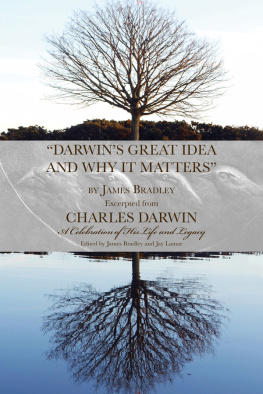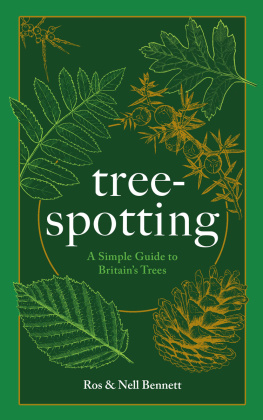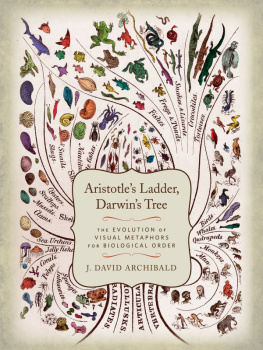ARISTOTLES LADDER, DARWINS TREE
Aristotles Ladder, Darwins Tree
The Evolution of Visual Metaphors for Biological Order
J. David Archibald
COLUMBIA UNIVERSITY PRESS

NEW YORK
Columbia University Press
Publishers Since 1893
New York Chichester, West Sussex
cup.columbia.edu
Copyright 2014 Columbia University Press
All rights reserved
E-ISBN 978-0-231-53766-7
Library of Congress Cataloging-in-Publication Data
Archibald, J. David.
Aristotles ladder, Darwins tree : the evolution of visual metaphors for biological order / J. David Archibald.
pages cm
Includes bibliographical references and index.
ISBN 978-0-231-16412-2 (cloth : alk. paper)
ISBN 978-0-231-53766-7 (e-book)
1. BiologyPhilosophy. 2. Human evolutionPhilosophy. 3. Imagery (Psychology) 4. Metaphor. I. Title.
QH315.A723 2014
570.1dc23
2013050622
A Columbia University Press E-book.
CUP would be pleased to hear about your reading experience with this e-book at .
COVER IMAGE: Frontispiece of Anna Maria Redfield, Zological Science, or, Nature in Living Forms (New York: Kellogg, 1858). (Courtesy of the author)
COVER AND TEXT DESIGN: Milenda Nan Ok Lee
References to Web sites (URLs) were accurate at the time of writing. Neither the author nor Columbia University Press is responsible for URLs that may have expired or changed since the manuscript was prepared.
For my father,
James R. Archibald (19272013)
Contents
Every culture that has put chisel to stone or pen to paper has attempted to visualize the order in nature and our place in it. Some of the more intriguing representations of the natural biological order remain with us in the form of grandiose spirals hypothesizing the relationships of thousands upon thousands of species. We have come a long way, but weve become so comfortable with these representations that we must remind ourselves that they are poetic metaphors rather than the scientific history of life on planet Earth. We blithely presume an underlying realitythat this natural biological order came about by the process of evolution. This realization emerged succinctly in only the past two centuries, whereas our graphic images and schemata remain only metaphors for this process and for the pattern or patterns that emerged over the past few thousand millennia. Shockingly, even in the self-described advanced cultures the very fact of evolution remains controversial mostly because of religious zealotry and ignorance.
The acceptance of evolution as the greatest force underlying nature emerged in Europe as science ascended the remaining steps to the throne of rationality. As might be expected, the ideas of evolution and in particular its visualization did not suddenly appear treading on the heels of the Enlightenment; rather, they exhibit a long and sometimes tangled history within the Western tradition. Ladders and trees became the common but not the only icons. The growth and blossoming of visual representations over the past 2,500 years and what they meant to those who created them encompass the theme of this book.
How we visualized natures order leading up to modern evolutionary biology by necessity includes or excludes various individuals and their ideas in a somewhat idiosyncratic manner. This pertains especially to important biologists from the nineteenth century onward. Accordingly, it must be emphasized that the basis for including or excluding an individual relates most specifically to whether this individual contributed a visual representation of biological order or in a few cases a written description of how to represent biological order.
Placing past events within the context of time and place proved a daunting task. Supposedly the more we know, the easier the task becomes. But we then face the situation of more experts weighing in on the meaning of this visual metaphor or that narrative. It is, to be sure, a dubious, untidy process for us humans to try to objectify ourselves, because we deem ourselves exceptions to the rest of the natural world. Having spent most of my career studying long-dead species that never possessed such an exalted view (if they possessed any view) of themselves, I fortunately could eliminate the issue of hubris in the subjects of study.
Studying long-dead creatures and their environments presents many variables, but one is not their view of their place in nature. Especially given the newer techniques of placing long-extinct species within their environmental context, with the overlay of knowing that all such species remain subject to the ravages and rewards of evolution, we paleontologists pride ourselves in placing organisms in a proper context of time and place. Such is not the case when interpreting human history, even when written. We run the risk of trying to place these sometimes very ancient ideas within in a modern context and placing modern sensibilities on them.
In this book, then, the task is to see a diagram not as we now interpret it but as the author and intellectually curious consumers at the time perceived it. Such diagramsladders, stairs, trees, tables, bifurcating figuresmeant one thing at the time they were created but, depending on the longevity of the figure, have affected both how we draw such diagrams today and how we interpret them. Does a tree figure with various species at its termini mean an evolutionary history? Does a simple bifurcating diagram of various species represent a genealogy? When we see diagrams of fish to amphibian to reptile to mammal to human, what do we perceive these representations mean? The answer depends on when and where the diagram appeared.
How do we measure progress in our understanding of the biological order? We can identify benchmarksamong others, Lamarcks use-disuse ideas and his tree in 1809; Darwins natural selection and his hypothetical tree in 1859; Haeckels many phylogenies in the latter nineteenth century; Simpsons help in reconciling Mendel and Darwin in the mid-twentieth century; and the rapid-fire introduction toward the end of the twentieth century of Hennigs cladistics, PCR, and related molecular techniques for phylogenetic reconstruction, and the repeatedly doubling of computing power. Building a scale of progress based on this sort of trajectory, we made slow progress for more than two thousand years, began picking up speed just over two hundred years ago, and turned vertically about fifty years ago. As we shall see, the visual metaphors for this incredible progress have not kept pace, and understandably so. As the number of species that we believe to exist and those we think exist took an equally astounding upward turn, our ability to put this in visual metaphors flagged. Who can grasp millions of interrelated species festooning the tree of life? Our computers can calculate and even attempt to draw such trees, but we must at some point simply look on in awe.
I thank Patrick Fitzgerald, my editor at Columbia University Press, for his early and strong support for this project, as well as two anonymous reviewers for their thoughtful comments. Bridget Flannery-McCoy, associate editor for the sciences, and Milenda Lee, senior designer at Columbia, offered their wonderfully helpful advice and thoughts in the preparation of this volume, as did Columbia editors Kathryn Schell and Irene Pavitt. Anita OBrien provided expert copyediting skills. Curtis Johnson gave useful input on . Gloria E. Bader and E. N. Genovese read the manuscript in great detail, supplying excellent critiques on language, syntax, and content, and provided suggestions for titles. For this I am especially grateful. Edward Cell read and commented on the completed text.









 NEW YORK
NEW YORK